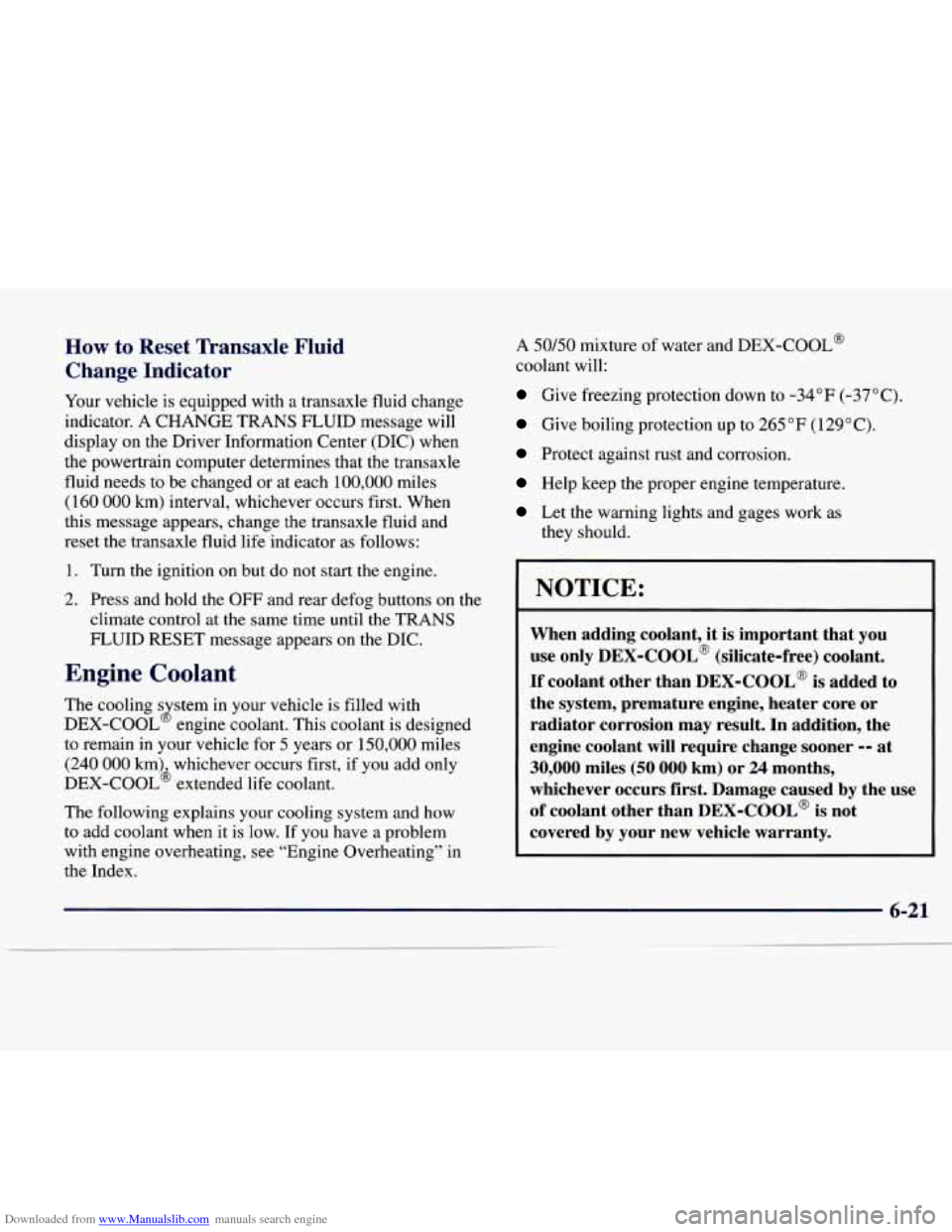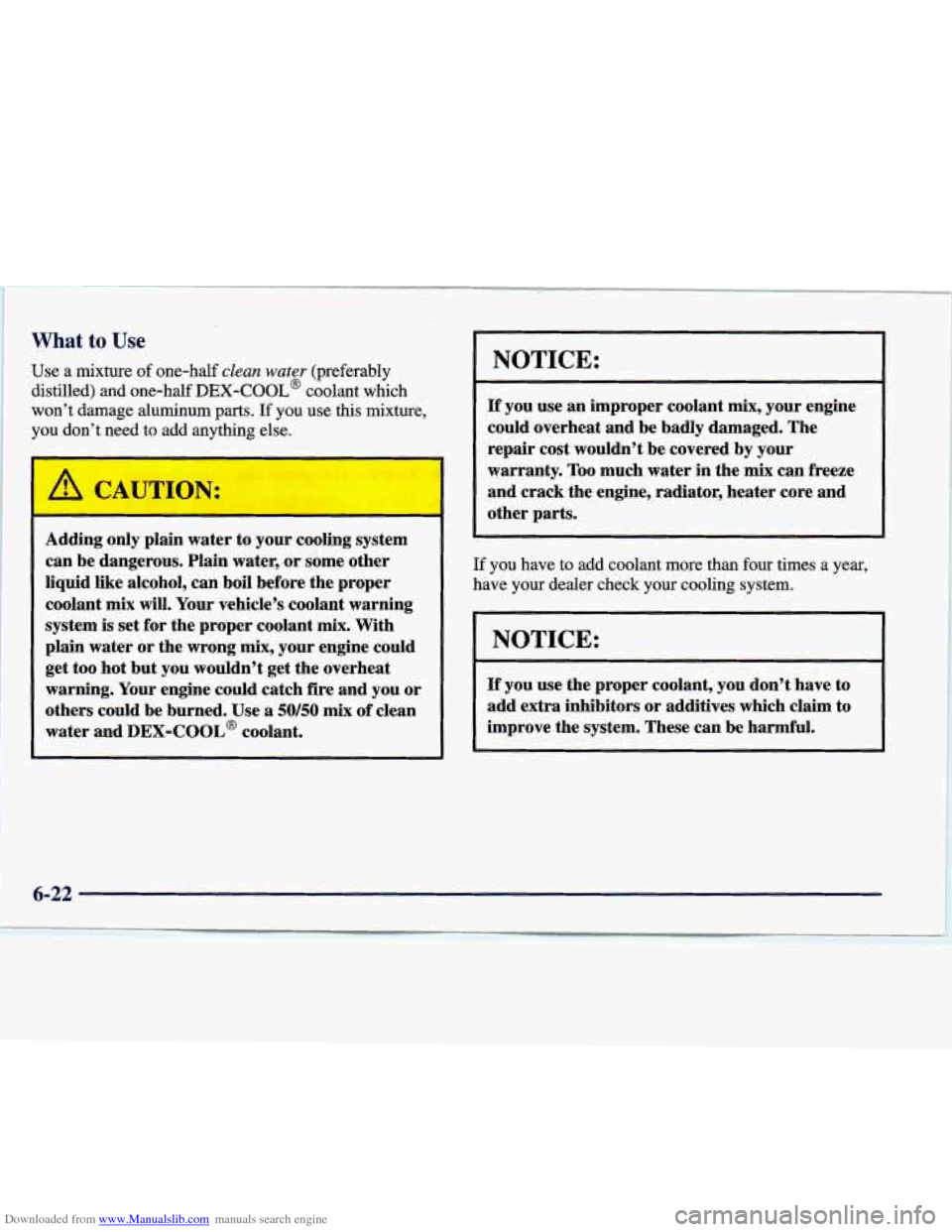engine coolant CADILLAC DEVILLE 1997 7.G Owner's Manual
[x] Cancel search | Manufacturer: CADILLAC, Model Year: 1997, Model line: DEVILLE, Model: CADILLAC DEVILLE 1997 7.GPages: 386, PDF Size: 21.61 MB
Page 265 of 386

Downloaded from www.Manualslib.com manuals search engine NOTICE:
In cold weather, water can freeze and crack the
engine, radiator, heater core and other parts.
So
use the recommended coolant.
I
You can be burned if you spill coolant on hot
engine parts. Coolant contains ethylene glycol
and it will burn
if the engine parts are hot
enough. Don’t spill coolant on
a hot engine.
1. You can remove the coolant surge tank pressure cap
when the cooling system, including the coolant surge
tank pressure cap and upper radiator hose, is no
longer hot. Turn the pressure cap slowly
counterclockwise
until it first stops. (Don’t press
down while turning the pressure cap.)
If you hear a hiss, wait for that to ston A hiss means
there is still some pressure left.
5-22
Page 266 of 386

Downloaded from www.Manualslib.com manuals search engine 2. Then keep turning the cap, but now push down as
you turn it. Remove the pressure cap. 3. Then fill the coolant surge tank with the proper mix,
up to the base of the filler neck.
5-23
Page 267 of 386

Downloaded from www.Manualslib.com manuals search engine 4. With the coolant surge tank pressure cap off, start the
engine and let it fun until you can feel the upper
radiator hose getting hot. Watch out for the
engine fans.
By this time, the coolant level inside the coolant surge tank
may be lower. If the level is lower, add
more
of the proper mix to the coolant surge tank
until the level reaches about
2.5 inches (6.4 cm)
below the base of the filler neck.
5. Then replace the pressure cap. Be sure the arrows on
the pressure cap line up like this.
Start the engine and allow it
to warm up. If the CHECK
COOLANT LEVEL message does not appear on the
Driver Information Center, coolant is at the proper fill
level. If
a CHECK COOLANT LEVEL message does
appear, repeat Steps
1 through 3 or see your dealer.
5-24
Page 284 of 386

Downloaded from www.Manualslib.com manuals search engine $z=* ‘dc
Section 6 Service and Appearance Care
Here you will find information about the care of your Cadillac. This section begins with service and fuel information,
and then it shows how to check important fluid and lubricant levels. There is also technical information about your
6-2 6-3
6-4
6-5
6-7
6-10
6-15
6-18
6-2
1
6-25
6-27
6-30
6-3
1
6-39
6-40
6-48
6-49
6-52
vehicle, and a part
devoted to its appearance care.
Service
Fuel
Fuels in Foreign Countries
Filling Your Tank
Checking Things Under the Hood
Engine Oil
Air Cleaner
Automatic Transaxle Fluid
Engine Coolant
Windshield Washer Fluid
Brakes
Battery
Bulb Replacement
Windshield Wiper Blade Replacement
Tires
Appearance Care
Cleaning the Inside of Your Cadillac
Care
of Safety Belts 6-52
6-5 3
6-53
6-53
6-54
6-55
6-55
6-56
6-57
6-58
6-58
6-59
6-69
6-69
6-70
6-70 Cleaning Glass
Surfaces
Cleaning the Outside of the Windshield and
Wiper Blades
Weatherstrips Cleaning the Outside of Your Cadillac
Cleaning Aluminum or Chrome Wheels
(If Equipped)
Cleaning Tires
Sheet Metal Damage
Chemical Paint Spotting
Appearance Care Materials Chart
Vehicle Identification Number
(VIN)
Service Parts Identification Label
Electrical System
Replacement Bulbs
Capacities and Specifications
Air Conditioning Refrigerants
Normal Maintenance Replacement Parts
6-1
Page 290 of 386

Downloaded from www.Manualslib.com manuals search engine When you put the cap back on, turn it to the right
(clockwise) until you hear
a clicking sound. Make sure
you fully install the cap.
NOTICE:
If you need a new cap, be sure to get the right
type. Your dealer can get one
for you. If you get
the wrong type, it may not
fit or have proper
venting, and your fuel tank and emissions system
might be damaged.
Checking Thiw~s Under the Hood
A CAU I ION: I
r- - I
An electric fan under the hood can start up and
injure you even when the engine is not running.
Keep hands, clothing and tools away from any
underhood electric fan.
Things that burn can get on hot engine parts and
start a fire. These include liquids like gasoline,
oil, coolant, brake fluid, windshield washer and
other fluids, and plastic or rubber. You or others
could be burned. Be careful not to drop or spill
things that will burn onto a hot engine.
6-7
I
Page 292 of 386

Downloaded from www.Manualslib.com manuals search engine When you open the hood, you'll see:
A. Battery
B. Coolant Fill Location
C. Power Steering Fluid D. Oil
Fill Location
E. Engine Oil Dipstick Location
E Brake Master Cylinder
G. Transaxle DipstickPill
H. Air Cleaner
I. Windshield Washer Fluid
Before closing the hood, be sure all filler caps are on properly. Then pull the hood down and close
it firmly.
Page 304 of 386

Downloaded from www.Manualslib.com manuals search engine How to Reset Transaxle Fluid
Change Indicator
Your vehicle is equipped with a transaxle fluid change
indicator.
A CHANGE TRANS FLUID message will
display
on the Driver Information Center (DIC) when
the powertrain computer determines
that the transaxle
fluid needs to be changed or at each
100,000 miles
(160 000 km) interval, whichever occurs first. When
this message appears, change the transaxle fluid and
reset
the transaxle fluid life indicator as follows:
1. Turn the ignition on but do not start the engine.
2. Press and hold the OFF and rear defog buttons on the
climate control at the same time until the
TRANS
FLUID RESET message appears on the DIC.
Engine Coolant
The cooling s stem in your vehicle is filled with
DEX-COOL engine coolant. This coolant is designed
to remain
in your vehicle for 5 years or 150,000 miles
(240 000 km) whichever occurs first, if you add only
DEX-COOL’ extended life coolant.
The following explains your cooling system and how
to add coolant when it is low. If you have a problem
with engine overheating, see “Engine Overheating” in
the Index.
J
A 50/50 mixture of water and DEX-COOL@
coolant will:
Give freezing protection down to -34°F (-37°C).
Give boiling protection up to 265 “F (129°C).
Protect against rust and corrosion.
Help keep the proper engine temperature.
Let the warning lights and gages work as
they should.
NOTICE: ~ ~~ ~ -
When adding coolant, it is important that you
use only
DEX-COOL@ (silicate-free) coolant.
If coolant other than DEX-COOL@ is added to
the system, premature engine, heater core or
radiator corrosion may result. In addition, the
engine coolant will require change sooner
-- at
30,000 miles (50 000 km) or 24 months,
whichever occurs first. Damage caused by the use
of coolant other than DEX-COOL@ is not
covered by your new vehicle warranty.
Page 305 of 386

Downloaded from www.Manualslib.com manuals search engine What to Use
Use a mixture of one-half clean water (preferably
distilled) and one-half
DEX-COOL@ coolant which
won’t damage aluminum
parts. If you use this mixture,
you don’t need to add anything else.
Adding only plain water to your cooling system
can be dangerous. Plain water, or some other
liquid like alcohol, can boil before the proper coolant
mix will. Your vehicle’s coolant warning
system is set for the proper coolant mix. With
plain water or the wrong mix, your engine could
get too hot but you wouldn’t get the overheat
warning. Your engine could catch fire and you or
others could be burned. Use a
50/50 mix of clean
water and
DEX-COOL@ coolant.
I NOTICE:
If you use an improper coolant mix, your engine
could overheat and be badly damaged. The
repair cost wouldn’t be covered by your
warranty.
Too much water in the mix can freeze
and crack the engine, radiator, heater core and
other parts.
If you have to add coolant more than four times a year,
have your dealer check your cooling system.
I NOTICE:
If you use the proper coolant, you don’t have to
add extra inhibitors or additives which claim to
improve the system. These can be harmful.
6-22
Page 306 of 386

Downloaded from www.Manualslib.com manuals search engine Checking Coolant
The surge tank is located next to the engine block on the
passenger’s side of the engine.
The cooling system
is under a lot of pressure when it is
hot.
If the CHECK COOLANT LEVEL message
appears on the DIC, you will need to add coolant.
”urning the surge tank pressure cap when the
engine and radiator are hot can allow steam and
scalding liquids to blow out and burn you badly.
Never turn the surge tank pressure cap
-- even a
little
-- when the engine and radiator are hot.
When your engine is cold, the coolant level should be at
the FULL COLD mark, which is
2.5 inches (6.4 cm)
below the base
of the fill neck. Use a flashlight as
necessary to see into the tank.
..... ......................... ................. ................... . ... ............ ............. ..I.. ... .................. ..................................... *....I. ...... . .”... ... ”.. ...... ...... .......... ....... ..... ................... ”
If this message comes on, it means you’re low on
engine coolant.
6-23
Page 307 of 386

Downloaded from www.Manualslib.com manuals search engine Adding Coolant
If you need more coolant, add the proper DEX-COOL@
coolant mixture at the surge tank, but only when the
engine is cool.
You can be burned if you spill coolant on hot
engine parts. Coolant contains ethylene glycol,
and it
will burn if'the engine parts are hot
enough. Don't spill coolant on
a hot engine.
When replacing the pressure cap, make sure it
is tight.
Surge Tank Pressure Cap
1 NOTICE:
The surge tank cap is a 15 psi (105 kPa)
pressure-type cap and must be tightly installed to
prevent coolant loss and possible engine damage
from overheating. Be sure the arrows on the cap
line up.
If the surge tank pressure cap needs to be replaced, a
General Motors cap
is recommended.
Thermostat
Engine coolant temperature is controlled by a thermostat
in the engine coolant system. The thermostat stops the
flow of coolant through the radiator until the coolant
reaches a preset temperature.
If your thermostat needs to be replaced, a General
Motors thermostat
is recommended.
6-24